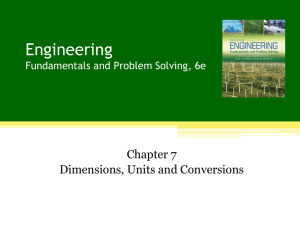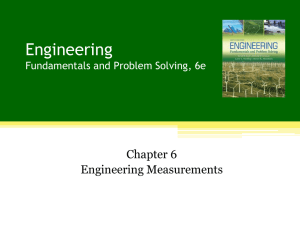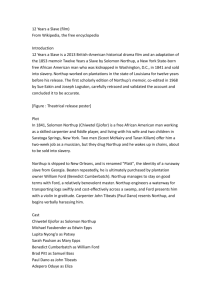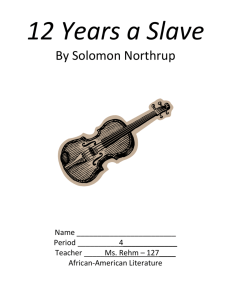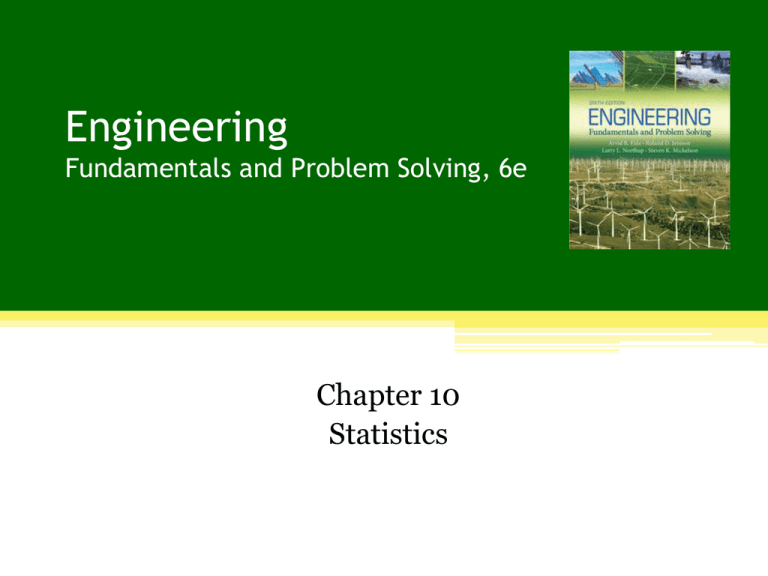
Engineering
Fundamentals and Problem Solving, 6e
Chapter 10
Statistics
Chapter Objectives
• Analyze a wide variety of data sets using
descriptive techniques (mean, mode, variance,
standard deviation, and correlation)
• Learn to apply the appropriate descriptive
statistical techniques in a variety of situations
• Create graphical representations of individual
and grouped data points with graphs and
histograms
Engineering: Fundamentals and Problem Solving, 6e
Eide Jenison Northup Mickelson
Copyright © 2012 by The McGraw-Hill Companies, Inc. All rights reserved.
2
Descriptive Statistics
• Used to summarize or describe important
features of a data set
• Parameters are calculated from available
observations
• Engineers generally contend with samples rather
than entire populations of data
Engineering: Fundamentals and Problem Solving, 6e
Eide Jenison Northup Mickelson
Copyright © 2012 by The McGraw-Hill Companies, Inc. All rights reserved.
3
Measures of Central Tendency or
Average
• MEDIAN – “Middle” value in a sample
• MODE – The most common value in the sample
(there may be more than one mode)
• MEAN – Arithmetic average
x
x
i
n
Engineering: Fundamentals and Problem Solving, 6e
Eide Jenison Northup Mickelson
Copyright © 2012 by The McGraw-Hill Companies, Inc. All rights reserved.
4
Measures of Variation
• Represent the amount of disparity (dispersal,
scatter) between the data points and the mean
• Variance
s
2
2
(x x)
• Standard Deviation
2
i
n 1
s s
2
Note: n-1 is the number of degrees of freedom left
after calculating n
Engineering: Fundamentals and Problem Solving, 6e
Eide Jenison Northup Mickelson
Copyright © 2012 by The McGraw-Hill Companies, Inc. All rights reserved.
5
Example – Measures of Variation
Example Problem 10.2
• Interstate Safety Corridors are established on certain
roadways with a propensity for strong cross winds, blowing
dust, and frequent fatal accidents.
• A driver is expected to turn on the headlights and pay special
attention to the posted speed limit in these corridors.
• In one such Safety Corridor in northern New Mexico, the
posted speed limit is 75 miles per hour.
• The Department of Public Safety set up a radar checkpoint
and the actual speed of 36 vehicles that passed the checkpoint
is shown in the Table below.
Engineering: Fundamentals and Problem Solving, 6e
Eide Jenison Northup Mickelson
Copyright © 2012 by The McGraw-Hill Companies, Inc. All rights reserved.
6
Example – cont’d
Actual speeds of cars in Safety Corridor
70
85
71
75
65
66
78
69
82
76
90
78
70
68
69
85
77
91
80
61
71
72
89
69
86
81
62
63
76
80
Engineering: Fundamentals and Problem Solving, 6e
Eide Jenison Northup Mickelson
Copyright © 2012 by The McGraw-Hill Companies, Inc. All rights reserved.
76
80
71
72
70
92
7
Example – cont’d
a.) Make a frequency distribution table using 5 as a class
width (e.g. 60.0 – 64.9)
b.) Construct a histogram
Highway Speed
9
Interval
Frequency
60-64.9
3
65-69.9
6
70-74.9
8
75-79.9
7
80-84.9
5
85-89.9
4
2
90-94.5
3
1
8
7
Frequency
6
5
4
3
0
60-64.9
65-69.9
70-74.9
75-79.9
Engineering: Fundamentals and Problem Solving, 6e
Eide Jenison Northup Mickelson
Copyright © 2012 by The McGraw-Hill Companies, Inc. All rights reserved.
80-84.9
85-89.9
90-94.5
8
Example – cont’d
c) The mean
x
x
i
n
2716
75.44
36
d) The standard deviation
n( xi ) 2 ( xi ) 2
n
(
n
1
)
1/ 2
36(207360) (2716)
36
(
35
)
2
1/ 2
8.3715
e) The variance
2 70.0825
Engineering: Fundamentals and Problem Solving, 6e
Eide Jenison Northup Mickelson
Copyright © 2012 by The McGraw-Hill Companies, Inc. All rights reserved.
9

